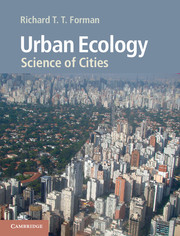Book contents
- Frontmatter
- Dedication
- Contents
- Foreword
- Preface
- Acknowledgments
- Part I Framework
- Part II Ecological features
- 4 Urban soil and chemicals
- 5 Urban air
- 6 Urban water systems
- 7 Urban water bodies
- 8 Urban habitat, vegetation, plants
- 9 Urban wildlife
- Part III Urban features
- Epilogue
- Appendix A Positive and negative attributes of an urban region
- Appendix B Equations
- References
- Index
8 - Urban habitat, vegetation, plants
Published online by Cambridge University Press: 05 June 2014
- Frontmatter
- Dedication
- Contents
- Foreword
- Preface
- Acknowledgments
- Part I Framework
- Part II Ecological features
- 4 Urban soil and chemicals
- 5 Urban air
- 6 Urban water systems
- 7 Urban water bodies
- 8 Urban habitat, vegetation, plants
- 9 Urban wildlife
- Part III Urban features
- Epilogue
- Appendix A Positive and negative attributes of an urban region
- Appendix B Equations
- References
- Index
Summary
There’s a tree that grows in Brooklyn. Some people call it the Tree of Heaven. No matter where its seed falls, it makes a tree that struggles to reach the sky. … the only tree that grows out of cement. It grows lushly … there are too many of it.
Betty Smith, A Tree Grows in Brooklyn, 1943The requirement to maintain species richness sets the most stringent limits on many forms of land use.
Gordon H. Orians, Environment, November 1990Suppose a chemical was accidentally released into the air and killed all the plants in a city. Would it matter? Would the city look slightly different, or fundamentally different? Would almost everyone leave?
Or perhaps only certain types of plants died – trees, flowers, or native species. Or, in only certain habitats – lawns, street trees, or woodlands. Or, it prevented flower formation, seed germination, or shrub growth. Or it cut biodiversity by 90%, or tripled the number of species. Or vegetation change slowed, or accelerated, tenfold. Or areas were hit at different intensity, reconfiguring the vegetation patterns of the urban landscape. While these are extreme examples, they point to many of the key patterns, processes, and changes to be explored in this chapter.
- Type
- Chapter
- Information
- Urban EcologyScience of Cities, pp. 205 - 240Publisher: Cambridge University PressPrint publication year: 2014
- 1
- Cited by



